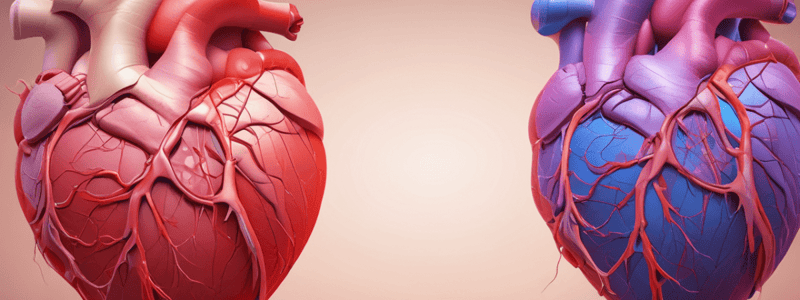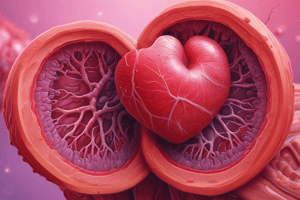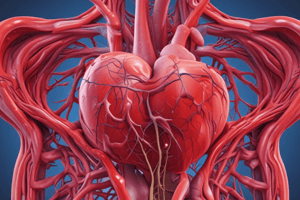Podcast
Questions and Answers
Which atrial arrhythmia is characterized by a heart rate of over 350 BPM?
Which atrial arrhythmia is characterized by a heart rate of over 350 BPM?
- Ventricular fibrillation
- Ventricular tachycardia
- Atrial flutter
- Atrial fibrillation (correct)
What is the term used when conduction is excessively delayed or stopped at the AV node or Bundle of His?
What is the term used when conduction is excessively delayed or stopped at the AV node or Bundle of His?
- Bundle branch block
- Atrial flutter
- First-degree block (correct)
- Ventricular fibrillation
What device may be required for serious life-threatening dysrhythmias?
What device may be required for serious life-threatening dysrhythmias?
- AED (Automatic Electric Defibrillator) (correct)
- Pacemaker
- Antiarrhythmic drugs
- Beta blockers
Which type of arrhythmia causes muscle fibers to contract independently and rapidly, leading to contractions ceasing?
Which type of arrhythmia causes muscle fibers to contract independently and rapidly, leading to contractions ceasing?
What characteristic makes a third-degree heart block different from a partial block?
What characteristic makes a third-degree heart block different from a partial block?
What is the main problem associated with coronary artery disease?
What is the main problem associated with coronary artery disease?
Which of the following statements about arteriosclerosis is correct?
Which of the following statements about arteriosclerosis is correct?
Where do atheromas typically form in the context of atherosclerosis?
Where do atheromas typically form in the context of atherosclerosis?
Which of the following is the leading cause of death in both women and men in the USA?
Which of the following is the leading cause of death in both women and men in the USA?
What is the difference between arteriosclerosis and atherosclerosis?
What is the difference between arteriosclerosis and atherosclerosis?
What is the primary cause of congestive heart failure?
What is the primary cause of congestive heart failure?
Which side of the heart typically fails first in congestive heart failure?
Which side of the heart typically fails first in congestive heart failure?
What is the primary compensation mechanism that the body uses to maintain cardiac output in congestive heart failure?
What is the primary compensation mechanism that the body uses to maintain cardiac output in congestive heart failure?
What structural changes occur in the heart during congestive heart failure?
What structural changes occur in the heart during congestive heart failure?
How does the sympathetic nervous system affect the heart in congestive heart failure?
How does the sympathetic nervous system affect the heart in congestive heart failure?
What is the most common cause of sudden death in patients after a myocardial infarction (MI)?
What is the most common cause of sudden death in patients after a myocardial infarction (MI)?
What can interfere with the normal conduction of electrical impulses in the heart?
What can interfere with the normal conduction of electrical impulses in the heart?
Which of the following statements about bradycardia is true?
Which of the following statements about bradycardia is true?
What is the most common type of dysrhythmia leading to hospital admissions?
What is the most common type of dysrhythmia leading to hospital admissions?
What is a possible mechanism for premature atrial contractions (PACs)?
What is a possible mechanism for premature atrial contractions (PACs)?
What is the main role of lipids or fats in atherosclerosis?
What is the main role of lipids or fats in atherosclerosis?
What is the main cause of hypercholesterolemia?
What is the main cause of hypercholesterolemia?
What is the main diagnostic test used to detect a myocardial infarction (heart attack)?
What is the main diagnostic test used to detect a myocardial infarction (heart attack)?
What is the most common symptom of a heart attack in women?
What is the most common symptom of a heart attack in women?
What is the significance of a high CRP (C-reactive protein) level in a heart attack?
What is the significance of a high CRP (C-reactive protein) level in a heart attack?
What is the main consequence of decreased cardiac output in congestive heart failure?
What is the main consequence of decreased cardiac output in congestive heart failure?
Why does left-sided congestive heart failure lead to pulmonary congestion?
Why does left-sided congestive heart failure lead to pulmonary congestion?
What effect does essential hypertension have on the left ventricle in congestive heart failure?
What effect does essential hypertension have on the left ventricle in congestive heart failure?
Why does right-sided congestive heart failure occur in individuals with pulmonary disease?
Why does right-sided congestive heart failure occur in individuals with pulmonary disease?
What are common signs of right-sided heart failure and systemic backup in congestive heart failure?
What are common signs of right-sided heart failure and systemic backup in congestive heart failure?
What is the main consequence of a left-to-right shunt?
What is the main consequence of a left-to-right shunt?
What is the main characteristic of cyanotic conditions?
What is the main characteristic of cyanotic conditions?
What is the main compensation mechanism in response to a heart defect?
What is the main compensation mechanism in response to a heart defect?
What is the most common symptom of a large congenital heart defect?
What is the most common symptom of a large congenital heart defect?
What is the most common treatment for congenital heart defects?
What is the most common treatment for congenital heart defects?
What is the primary treatment for aortic valve stenosis?
What is the primary treatment for aortic valve stenosis?
How often do patients with a replaced aortic valve typically need to have it replaced again?
How often do patients with a replaced aortic valve typically need to have it replaced again?
What medication do patients with a replaced aortic valve typically need to take?
What medication do patients with a replaced aortic valve typically need to take?
What is the most common type of animal valve used to replace an aortic valve?
What is the most common type of animal valve used to replace an aortic valve?
What is the key feature of Tetralogy of Fallot?
What is the key feature of Tetralogy of Fallot?
What is the primary surgical treatment for Tetralogy of Fallot?
What is the primary surgical treatment for Tetralogy of Fallot?
What percentage of adults are considered pre-hypertensive?
What percentage of adults are considered pre-hypertensive?
Which group has the highest prevalence and earliest onset of hypertension?
Which group has the highest prevalence and earliest onset of hypertension?
What is the first-line treatment for hypertension?
What is the first-line treatment for hypertension?
What is the term used to describe hypertension that is extremely high and life-threatening?
What is the term used to describe hypertension that is extremely high and life-threatening?
Flashcards are hidden until you start studying




